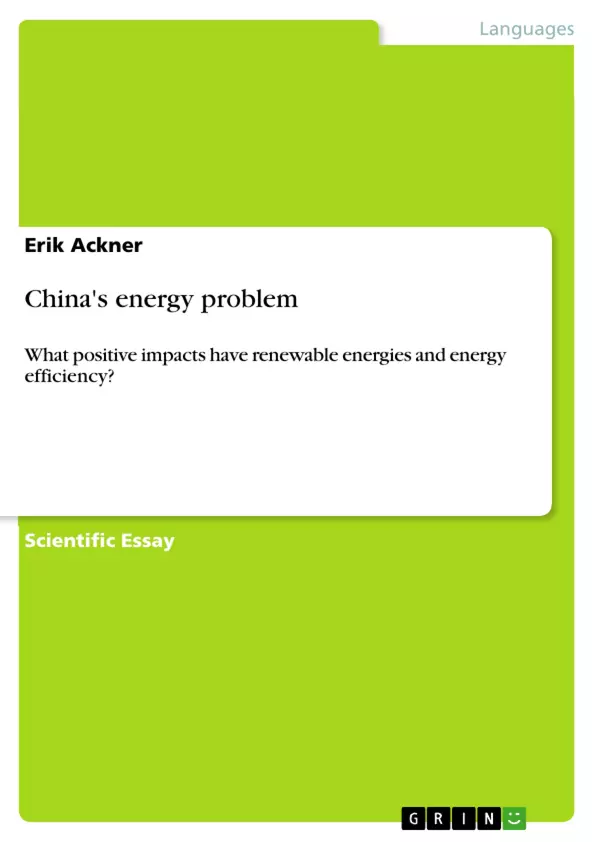In March 2011 the communist party (CP) of the People’s Republic of China (PRC) enacted their 12th Five-Year Plan for the period between 2011 to 2015. Previous charters were mainly focused on strong economic growth causing severe energy and environmental problems due to very high CO2 emissions. Scientists worldwide agree that the greenhouse gas carbon dioxide is the main driver for global warming and climate change.
What can be done so limit this development? Can maybe the 12th Five-Year Plan of China act as a good example?
The latest plan of the PRC eventually is giving a slight change to its old philosophy by setting on the agenda “three energy related priorities: the diversification of sources and development of clean energies; energy efficiency and energy conservation; and the development of electric vehicles” (Enerdata Ltd., 2013: 5). By publishing these objectives, the CP acknowledges a previous maldevelopment in energy and environmental aspects, which go hand in hand.
This paper tries to give answers to the following questions:
What is the status quo of China’s energy market?
Which environmental problems is China facing?
What technical challenges exist when turning China’s energy market into a more sustainable one?
What part can Renewable Energies play to decrease emission?
What key role does energy efficiency play in China’s energy market?
What can be a possible outlook?
Inhaltsverzeichnis (Table of Contents)
- Executive Summary
- What is China's energy status quo?
- Introduction
- Energy demand
- Energy supply
- Challenges
- China's environmental problems
- Technical issues of changing China's energy system
- Renewable Energies and Energy Efficiency
- Status quo and potential of Renewable Energies (RE)
- Status quo and potential of Energy Efficiency (EE)
- Outlook
Zielsetzung und Themenschwerpunkte (Objectives and Key Themes)
This paper examines the current state of China's energy market and analyzes the challenges and opportunities presented by the country's 12th Five-Year Plan, which emphasizes the development of renewable energies and energy efficiency. The paper aims to answer key questions regarding the status quo of China's energy market, the environmental challenges it faces, the technical hurdles in transitioning to a sustainable energy system, and the roles of renewable energies and energy efficiency in achieving this transition. The paper also explores a possible outlook for the future of China's energy sector.- China's energy consumption and its environmental impact.
- Challenges and opportunities in transitioning to a more sustainable energy system.
- The role of renewable energies in reducing emissions.
- The importance of energy efficiency in China's energy market.
- Potential outlook for the future of China's energy sector.
Zusammenfassung der Kapitel (Chapter Summaries)
The paper begins with an overview of China's energy status quo, highlighting its position as the world's largest energy consumer. It examines China's primary energy consumption, emphasizing the significant proportion used directly in production facilities, transportation, and other sectors, rather than being transformed into electricity. The paper then delves into the challenges China faces, specifically focusing on environmental problems associated with its reliance on fossil fuels. The text explores the technical hurdles in shifting towards a more sustainable energy system, such as infrastructure development and the integration of renewable energy sources. The final section addresses the potential of renewable energies and energy efficiency in mitigating China's energy challenges. It examines the status quo and potential of each approach, suggesting their crucial roles in reducing emissions and building a more sustainable energy future.Schlüsselwörter (Keywords)
The paper focuses on the key topics of China's energy consumption, environmental challenges, renewable energies, energy efficiency, and the transition towards a more sustainable energy system. Key terms include: primary energy consumption, renewable energy sources, energy efficiency, environmental impact, technical challenges, and sustainable energy. The paper uses a combination of quantitative data and qualitative analysis to provide a comprehensive overview of China's energy situation and its potential for a greener future.- Quote paper
- Erik Ackner (Author), 2014, China's energy problem, Munich, GRIN Verlag, https://www.hausarbeiten.de/document/272196


